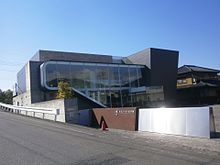Japan and the Holocaust
Although Japan was a member of the Axis, and therefore an ally of Nazi Germany, it did not actively participate in the Holocaust.[a] Anti-semitic attitudes were insignificant in Japan during World War II and there was little interest in the Jewish question, which was seen as a European issue.[6] Furthermore, Nazi Germany did not pressure Japan on the issue.[6]
Background

In 1936, the
During World War II
On December 6, 1938, the Japanese government made a decision of prohibiting the expulsion of the Jews in Japan, Manchukuo, and the rest of Japanese-occupied China. This was described as "amoral", based primarily on the consideration of avoiding antagonizing the United States. Even after Japan and United States became involved in a war against each other, the Japanese government's neutrality towards the Jews continued.[7]: 111–12
Japanese media reported on the rising

In 1941,
In 1940–1941, Japanese diplomat
Many Jewish scientists were involved in the Manhattan Project; Meron Medzini noted that they did not object to dropping the atomic bomb on Japan instead of Germany; and that "we do not know if the [Jewish] scientists were aware that Japan was not involved in the Holocaust", also observing that much of their information about Japan must have come from American wartime propaganda, which sought to "demonize and dehumanize the Japanese people".[26]
After the war

Awareness of the Holocaust in Japan did not immediately increase after the war ended, as neither the Japanese authorities nor the United States occupying forces saw the topic as particularly significant. This changed in the early 1950s, as the topic became popularized by the translation of
On the other hand, Holocaust denial views also spread, particularly since the 1980s, popularized among others by works of Masami Uno.[6] In February 1995, a magazine named Marco Polo (マルコポーロ), a 250,000-circulation monthly aimed at Japanese males, ran a Holocaust denial article; it was criticized and the magazine shut down shortly afterward.[6][27]
Japanese officials and scholars often compared American detention camps for the Japanese to the Nazi concentration camps, which has been criticized as part of attempting to minimize Japanese's role as the aggressor in WWII.[6]
See also
Notes
- ^ This article refers to the Holocaust of the Jewish people. Some scholars also use the term holocaust in the context of the Japanese war crimes against Chinese, Koreans and people of other lands occupied by the Japanese empire.[1][2] The term "Japanese Holocaust" has also been used to describe the atomic bombings of Hiroshima and Nagasaki.[3][4][5]
References
- ISBN 978-1-351-51324-1. Archivedfrom the original on 2021-09-17. Retrieved 2021-09-17.
- ISBN 978-1-317-46415-0. Archivedfrom the original on 2021-09-17. Retrieved 2021-09-17.
- ISBN 978-1-137-27277-5. Archivedfrom the original on 2021-09-17. Retrieved 2021-09-17.
- ISBN 978-1-134-31399-0. Archivedfrom the original on 2021-09-17. Retrieved 2021-09-17.
- ISBN 978-0-520-25944-7. Archivedfrom the original on 2021-09-17. Retrieved 2021-09-17.
- ^ from the original on 2021-09-16. Retrieved 2021-09-16.
- ^ ISBN 9780739101674– via Google Books.
- ISBN 3596260841.
- ^ ISBN 9781107034075.
- ^ Weinberg, Gerhard L. (1954). "Die geheimen Abkommen zum Antikominternpakt. Dokumentation" (PDF). Vierteljahrshefte für Zeitgeschichte (in German). 1954/2: 193–201 – via Institut für Zeitgeschichte.
- ISBN 0198228864.
- ISBN 0801403715. Retrieved 23 October 2020.
- ISBN 0850668336.
- ^ Japanese, Nazis & Jews: The Jewish Refugee Community in Shanghai, 1938–1945 by David Kranzler. p. 207.
- ISBN 9652293296
- ^ O'Neill, Mark, "A Saved Haven: Plans to rejuvenate Shanghai's rundown former Jewish ghetto will celebrate the district's role as a sanctuary during the Second World War", South China Morning Post, August 1, 2006; Features: Behind the News; p. 11.
- ^ "Jane Shlensky, "Considering Other Choices: Chiune Sugihara's Rescue of Polish Jews," North Carolina School of Science and Mathematics Durham, NC, 2003, p. 6" (PDF). Archived from the original (PDF) on 2012-03-08. Retrieved 2013-07-08.
- ^ a b Tyler, Patrick E. (29 June 1994). "Patrick E. Tyler, "Jews Revisit Shanghai, Grateful Still that it Sheltered Them." New York Times, June 29, 1994". The New York Times. Archived from the original on July 25, 2021. Retrieved September 16, 2021.
- S2CID 170786901.
- ISBN 0803223684.
- ^ "Feng-Shan Ho". yadvashem.org. Archived from the original on 2021-09-16. Retrieved 2021-09-16.
- ISBN 9780761819714– via Google Books.
- ^ "Polish Jews in Lithuania: Escape to Japan". encyclopedia.ushmm.org. Archived from the original on 2021-09-16. Retrieved 2021-09-16.
- ^ a b "Chiune (Sempo) Sugihara". encyclopedia.ushmm.org. Archived from the original on 2021-09-16. Retrieved 2021-09-16.
- ISBN 978-0-275-96199-2. Archivedfrom the original on 2021-09-16. Retrieved 2021-09-16.
- ISBN 978-90-04-21300-5. Archivedfrom the original on 2021-09-17. Retrieved 2021-09-17.
- ISBN 978-0-313-35384-0. Archivedfrom the original on 2021-09-17. Retrieved 2021-09-17.
